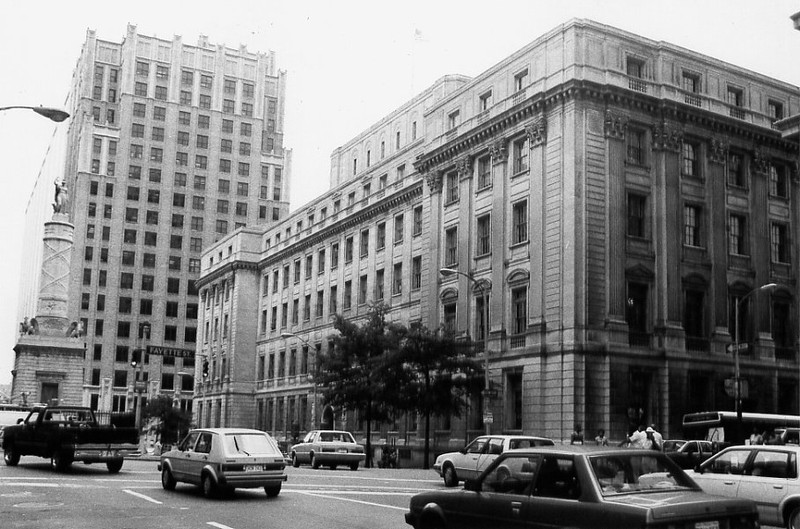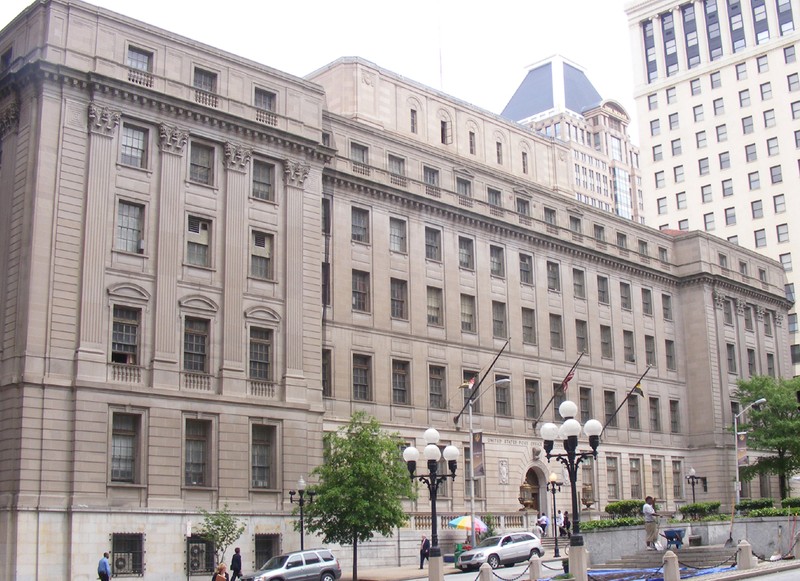United States Post Office and Courthouse
Introduction
Text-to-speech Audio
Images
Baltimore Post Office and Courthouse

Courthouse East

Demonstration Outside Trial of the Catonsville Nine

Backstory and Context
Text-to-speech Audio
George Mische and Daniel Berrigan convinced notable civil rights lawyer William Kunstler (a director of the ACLU known for defending the Mississippi Freedom Riders and Lenny Bruce, among so many others) to take their case. He was joined by a team of skilled attorneys, including Harrop Freeman (a Quaker and professor of law at Cornell), Father William Cunningham (a Jesuit and professor of law at Loyola University), and Harold Buchman (a local Baltimore attorney and champion of humanist causes).
The trial started on October 7, 1968, only six weeks after the disastrous Democratic Convention in Chicago, where clashes between anti-war protestors and police led to violence and riots. The trial of the Catonsville Nine would provide another lightning rod for anti-war protestors, and supporters of the Nine made plans for events and actions to draw national attention to their cause.
The Nine and their lawyers began the trial by declining to participate in the jury selection, a symbolic gesture representing their lack of faith in the criminal justice system, and their belief that there was no way in which they could receive a fair trial.
Judge Roszel Thomsen, though firm in his belief in the right of law, allowed the defendants a large amount of leeway, giving them the chance to speak about their beliefs, their background, and the motivations behind their action. As William Kuntsler stated, “the defendants are not going to deny doing what the evidence shows they did. They’re proud of it, and they think it is one of the shining moments of their own personal lives”.
Each of the Nine had a chance to speak about the experiences that led to their dramatic action. David Darst spoke to his experience working in the inner city, and noted that it is “astonishing… that our country cannot command the energy to give bread and milk to children, yet it can rain fire and death on people ten thousand miles away for reasons that are unclear to thoughtful men”. Philip Berrigan spoke to the guilt of those in charge of American foreign policy. George Mische discussed his experiences working in Latin America and the repressive dictatorships that the US had helped to foster there. He also addressed the illegality of carrying out war actions in Vietnam when Congress had not declared war.
Thomas Melville also condemned national policy and spoke of his experiences in Guatemala, and the involvement of Americans in executions carried out there. Mary Moylan discussed her experiences in Uganda, as well as her work among the African American community in DC, and how the injustices in both places had inspired her to stand up. Tom Lewis spoke about civil disobedience being “well documented in Christianity”, and his understanding that those practicing it often faced severe consequences, but that for him, “it was a choice between saving one’s soul and losing it”.
John Hogan spoke about the making of Napalm, about the devastation it caused in Vietnam. Marjorie Melville shared her experiences in Guatemala and Central America, and her desire to draw attention to the terrible things the U.S. government was doing there, as she stated, “I wanted to make as effective a protest as possible to U.S. military intervention across the world”. Daniel Berrigan was the last to give his testimony, and he spoke eloquently of his experiences at home and abroad, including his trip to Vietnam earlier that year. He discussed his evolution as a man, and as a man of faith, and asked, “how can we survive as human beings in a world more and more officially given over to violence and death… I was threatened with verbalizing my moral substance out of existence”.
In closing arguments, William Kuntsler argued that the case of the Catonsville Nine was unique. “The trial of Socrates was not merely a question of a man sowing confusion and distrust among the youth of Athens; the trial of Jesus could not be reduced to one conspiracy against the Empire... [t]he defendants weren’t burning files for the sake of burning files.”
In rebuttal, the prosecution argued that “the problems of the United States are not going to be solved by people who deliberately violate the duly enacted laws of the United States”, and the judge reiterated that “the law does not recognize political, religious, moral convictions, or some higher law, as justification for the commission of a crime, no matter how good the motive may be.”
When the jury exited the courtroom to deliberate, the judge allowed the Nine to speak about the trial, and they debated with the judge about what had happened in front of the crowded courtroom. Finally, they ended by requesting the judge allow them to pray. The prosecution and the judge agreed, and the Nine linked hands and spoke the “Our Father” and were joined by all the spectators.
After, the jury returned, and the defendants were all found guilty.
Sources
Berrigan, Daniel. The Trial of the Catonsville Nine. Boston: Beacon Press, 1970.
Julius, Marilyn. “Fire and Faith.” The Catonsville Nine File, 2005. http://c9.digitalmaryland.org/
Peters, Shawn Francis. The Catonsville Nine: A Story of Faith and Resistance in the Vietnam Era. New York: Oxford University Press, 2012.
Stacy, Jim. “Iterations of Conscience in Performance: the Catonsville Nine, Their Protest, Their Trial, and Their Docudramas.” Theatre Symposium, vol. 14, 2006, pp. 90–103.
Stone, I.F. They Pleaded Guilty Of Burning Paper Instead of Children. I.F. Stone's Weekly. October 21st 1968.
United States Post Office and Courthouse, Maryland's National Register Properties. Accessed November 1st 2020. https://mht.maryland.gov/nr/NRDetail.aspx?NRID=420.
Maryland's National Register Properties, Photo credit: Fred B. Shoken, 07/1985
By Marylandstater (talk) - Own work (Original text: self-made), Public Domain, https://commons.wikimedia.org/w/index.php?curid=10801065
http://www.catonsville9.org/
